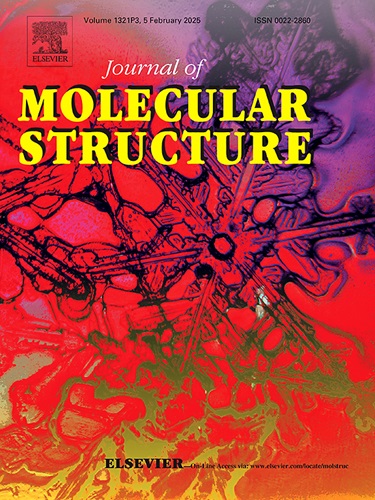Synthesis, XRD analysis, FTIR and Raman spectroscopy, Hirshfeld surface analysis and density functional theory of NLO material L-phenylalanine L-phenylalaninium malonate
IF 4
2区 化学
Q2 CHEMISTRY, PHYSICAL
引用次数: 0
Abstract
L-phenylalanine l-phenylalaninium malonate (LPLPM) single crystal is considered one of the amino-based nonlinear optical materials for applications in the optoelectronics field. It was grown using a slow evaporation method at room temperature. Single crystal XRD studies have confirmed that the grown crystal belongs to a monoclinic structure with non-centrosymmetric space group P21. The lattice parameters of the grown crystal were found to be as a = 14.02 Å (4), b = 5.40 Å (10), c = 14.61Å (4) and α = γ = 90°, β = 107.41° (3) and V = 1075.6 ų (4). The molecular structure and crystal system were also carefully examined using single crystal and powder XRD investigations. The FTIR and Raman spectra were recorded and analyzed for the confirmation of functional groups and the corresponding vibrational modes. Density functional theory (DFT) calculations of the sample have been done to determine the optimized geometry of the material from vibrational assignments. The optimized geometrical parameters obtained from the DFT calculations match well with the experimentally obtained results of FTIR and Raman spectral studies. Frontier molecular orbital analysis was performed to understand the electronic structure and the reactivity of molecules. The energy gap of the compound was found to be 6.0632 eV from the HOMO-LUMO analysis. The higher value of total first hyperpolarizability βtot = 146.784 × 10−31 e.s.u. reflects the potential of the material for the nonlinear optical response. An attempt has been made to study Hirshfeld surface analysis of the crystal structure to gain deeper insight into the intermolecular interactions present among the molecules. Kurtz and Perry powder technique confirmed the nonlinear optical property of the material and the second harmonic generation efficiency of the LPLPM was found to be 0.4 times that of standard material KDP. The various characterization studies of LPLPM are very interesting in understanding the physico-chemical properties of the material LPLPM for technological applications. Furthermore, NBO analyses, Fukui function and Mulliken population analysis of LPLPM were included to understand the chemical parameters, inter-molecular interactions and the reactivity of the compound in the supplementary material section.
NLO材料l -苯丙氨酸的合成、XRD分析、FTIR和Raman光谱、Hirshfeld表面分析和密度泛函理论
l-苯丙氨酸-丙二酸苯丙氨酸(LPLPM)单晶被认为是光电子领域应用的氨基非线性光学材料之一。它是在室温下用缓慢蒸发法生长的。单晶XRD研究证实,生长的晶体属于单斜晶结构,具有非中心对称空间群P21。晶体的晶格参数分别为a = 14.02 Å (4), b = 5.40 Å (10), c = 14.61Å (4), α = γ = 90°,β = 107.41°(3),V = 1075.6 ų(4)。用单晶和粉末XRD研究了分子结构和晶体体系。记录和分析了FTIR和拉曼光谱,以确定官能团和相应的振动模式。对样品进行了密度泛函理论(DFT)计算,从振动赋值中确定了材料的优化几何形状。由DFT计算得到的优化几何参数与FTIR和拉曼光谱的实验结果吻合较好。通过前沿分子轨道分析来了解分子的电子结构和反应性。通过HOMO-LUMO分析发现化合物的能隙为6.0632 eV。总第一超极化率β = 146.784 × 10−31 e.s.u.反映了材料非线性光学响应的潜力。为了更深入地了解分子间的相互作用,我们尝试对晶体结构进行赫希菲尔德表面分析。Kurtz和Perry粉末技术证实了材料的非线性光学特性,发现LPLPM的二次谐波产生效率是标准材料KDP的0.4倍。LPLPM的各种表征研究对于了解LPLPM材料的物理化学性质以用于技术应用是非常有趣的。此外,通过NBO分析、Fukui函数分析和Mulliken种群分析,在补充材料部分了解了化合物的化学参数、分子间相互作用和反应性。
本文章由计算机程序翻译,如有差异,请以英文原文为准。
求助全文
约1分钟内获得全文
求助全文
来源期刊

Journal of Molecular Structure
化学-物理化学
CiteScore
7.10
自引率
15.80%
发文量
2384
审稿时长
45 days
期刊介绍:
The Journal of Molecular Structure is dedicated to the publication of full-length articles and review papers, providing important new structural information on all types of chemical species including:
• Stable and unstable molecules in all types of environments (vapour, molecular beam, liquid, solution, liquid crystal, solid state, matrix-isolated, surface-absorbed etc.)
• Chemical intermediates
• Molecules in excited states
• Biological molecules
• Polymers.
The methods used may include any combination of spectroscopic and non-spectroscopic techniques, for example:
• Infrared spectroscopy (mid, far, near)
• Raman spectroscopy and non-linear Raman methods (CARS, etc.)
• Electronic absorption spectroscopy
• Optical rotatory dispersion and circular dichroism
• Fluorescence and phosphorescence techniques
• Electron spectroscopies (PES, XPS), EXAFS, etc.
• Microwave spectroscopy
• Electron diffraction
• NMR and ESR spectroscopies
• Mössbauer spectroscopy
• X-ray crystallography
• Charge Density Analyses
• Computational Studies (supplementing experimental methods)
We encourage publications combining theoretical and experimental approaches. The structural insights gained by the studies should be correlated with the properties, activity and/ or reactivity of the molecule under investigation and the relevance of this molecule and its implications should be discussed.
 求助内容:
求助内容: 应助结果提醒方式:
应助结果提醒方式:


